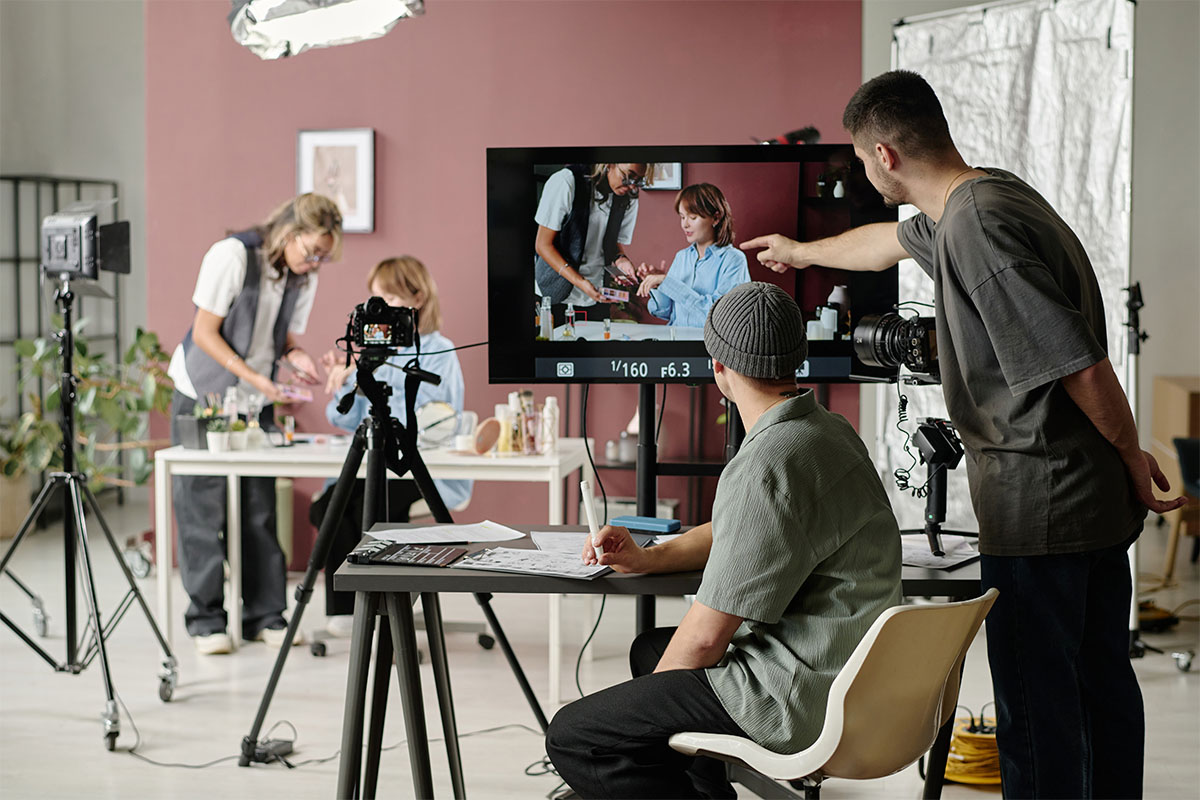
Video Production Companies: Aristotle’s Modes of Persuasion
When you watch Coca-Cola’s “Open Happiness” campaign, it is easy to simply enjoy the upbeat music and feel-good visuals of people laughing, sharing a Coke, and embracing life’s small moments. Most viewers likely do not realise how the brand is subtly influencing their emotions and perceptions. In reality, the campaign is a masterclass in using Aristotle’s modes of persuasion—ethos, pathos, and logos—to create a narrative that draws people in. Aristotle’s three methods of persuasion have been used for centuries to influence people’s decisions and actions. In video production, these principles are just as valuable today as they were in ancient Greece. The ethos of Coca-Cola is clear; the brand has long been associated with joy, community, and positive moments, positioning itself as trustworthy and familiar. The ad taps into pathos by evoking feelings of happiness and connection. And while there is little direct appeal to logos, the idea that Coca-Cola enhances life’s joyful moments presents a logical connection between the product and the emotions it generates. This kind of strategic use of persuasion is something video production companies expertly incorporate into marketing campaigns. By applying Aristotle’s principles, they create videos that both entertain and guide the audience toward a desired action. In this article, we will explore how video production companies use ethos, pathos, and logos to create marketing videos that appeal to audiences and influence consumer behaviour.
Understanding Aristotle’s Modes of Persuasion
Before diving into how these principles work in video production, it is important to understand what they are.
- Ethos (Credibility): Ethos refers to the character and credibility of the speaker or brand. When applying ethos in video marketing, the goal is to build trust and establish authority. If a brand’s message is delivered by someone viewed as an expert or a trustworthy figure, the audience is more likely to be persuaded.
- Pathos (Emotion): Pathos is about stirring emotions in the audience. This appeal taps into feelings, whether that is joy, fear, anger, or empathy. By invoking a strong emotional response, videos can engage viewers on a deeper level, encouraging them to act based on their emotional reactions.
- Logos (Logic): Logos is the appeal to reason and logic. It involves presenting facts, statistics, and logical arguments to persuade an audience. In a video, logos might be conveyed through data, clear reasoning, or a demonstration that shows how a product or service works.
How Video Production Companies Apply Persuasion
Video production companies are in a unique position to employ all three modes of persuasion—ethos, pathos, and logos—in their work. Let us take a closer look at how these persuasive methods can be applied at different stages of video production.
Pre-Production: Laying the Foundation
In the pre-production phase, video producers must plan how to incorporate ethos, pathos, and logos into the script, visuals, and messaging.
- Ethos in Pre-Production: The script should introduce credible figures or authoritative voices to reinforce the message. For example, a video for a health company may feature a respected doctor to discuss the benefits of a product, or a financial institution might include testimonials from satisfied clients. Establishing credibility early on sets the tone for the rest of the video.
- Pathos in Pre-Production: Identifying the emotions the video aims to evoke is important in this phase. If a video is meant to inspire hope, for instance, the producers should consider how to weave in visual cues (like uplifting music or uplifting imagery) that align with this emotion. The choice of setting, actors, and even the narrative style can be influenced by the emotion the video seeks to provoke.
- Logos in Pre-Production: During the planning stage, logical elements such as facts, figures, and testimonials should be integrated into the script. These elements will lay the groundwork for the video’s argument, which will be supported later with data or demonstrations. In a product video, for example, logos might include clear, concise explanations of how the product works and why it is beneficial.
Production: Creating the Persuasive Experience
The production phase is where the video really starts to take shape. This is when ethos, pathos, and logos are brought to life visually, using a combination of storytelling techniques, visuals, sound, and performance.
- Ethos in Production: Visual elements that enhance credibility are essential in this stage. The choice of speaker, their appearance, and the setting all contribute to the ethos of the video. A professional production with a refined presentation reinforces the message that the company or brand behind the video is credible and trustworthy. Additionally, on-screen text or voiceovers that mention awards, certifications, or other forms of recognition can help build trust.
- Pathos in Production: The emotional appeal is expressed through the tone of the video, music, and visual elements. For instance, a video with a heartwarming story about a company’s community involvement might be paired with uplifting music and images of real people benefiting from the brand’s actions. By combining these emotional elements, the video can create a genuine emotional connection with viewers, prompting them to act.
- Logos in Production: Presenting logical, clear, and well-structured information is the key to a successful logos appeal. This could include showing how a product works through a step-by-step demonstration, offering solid data on the product’s benefits, or presenting customer reviews that support the logical argument being made. The key is to avoid overwhelming the viewer with too much information while still conveying the facts clearly.
Post-Production: Refining and Strengthening Persuasion
In post-production, the video is edited and finalised to ensure that all three modes of persuasion work together.
- Ethos in Post-Production: The final draft of the video can emphasise credibility by ensuring the video is free of errors, looks professional, and aligns with the brand’s established image. Text overlays, titles, and even voiceovers can reiterate credibility by referencing trusted sources or expert opinions. Ensuring high-quality editing and sound can also support the notion that the brand values professionalism.
- Pathos in Post-Production: In the editing process, music and pacing play a large role in the emotional impact of the video. For example, adding a heartfelt background track can intensify the emotions expressed in the visuals. Additionally, timing is crucial—knowing when to slow down the pacing or include a poignant moment can make all the difference in evoking the desired emotional response from the audience.
- Logos in Post-Production: This phase is where you can really emphasise the logical appeal by incorporating visuals of data, facts, or infographics that support your message. For example, showing statistics in an animated graph or highlighting key product features with clean, easy-to-read text can reinforce the logical appeal. These visual cues help drive home the message in a digestible format that supports the audience’s rational decision-making process.
Case Studies: Real-World Examples
Understanding how video production companies use these persuasive techniques in practice is helpful. Let us look at a couple of examples where ethos, pathos, and logos were applied successfully:
- Colgate’s “9 out of 10 Dentists” Campaign
Colgate’s long-running campaign claims “9 out of 10 dentists recommend” its toothpaste, effectively using both ethos and logos to persuade consumers.- Ethos: By referencing dental professionals, Colgate builds trust, positioning its product as a trusted choice in oral care.
- Logos: The simple statistic appeals to logic, offering clear evidence that the product is highly recommended by experts.
This combination has helped Colgate maintain its strong position in the oral care market, as consumers are reassured by both expert endorsement and logical evidence.
- Nike’s “Just Do It” Campaign
Nike’s “Just Do It” campaign, launched in 1988, has become a hallmark of motivational marketing.- Pathos: The campaign taps into the emotions of viewers by showcasing athletes overcoming challenges, inspiring audiences to push their own limits.
- Ethos: By featuring high-profile athletes like Michael Jordan and Serena Williams, Nike adds credibility, associating its brand with excellence in sports.
The campaign’s powerful emotional appeal and credibility have helped Nike become synonymous with inspiration and performance, further solidifying its leadership in sportswear.
Final Thoughts
When it comes to video marketing, persuasion is not just about a catchy tagline or a memorable slogan. It is about tapping into the deeper currents of human emotion, trust, and logic. Aristotle’s ethos, pathos, and logos have stood the test of time because they are fundamental to how we, as people, make decisions and connect with the world around us. For video production companies, these principles are the tools that help them create videos that engage audiences but also drive real behavioural change, making viewers more likely to take meaningful actions, whether that is making a purchase or supporting a cause.
So, the next time you watch a marketing video that makes you smile, think twice. It is not just a coincidence. There is a good chance the creators behind it have carefully woven together these persuasive strategies to make sure you remember their message. And that is the power of persuasion—subtle, but incredibly effective when done right.
If you are looking to incorporate these persuasive methods into your own marketing videos while maintaining balance and ethics, it is important to partner with a video production company that has a proven track record of implementing these techniques in a way that makes an impact without manipulation. When done well, these principles do not feel like persuasion at all. They feel like something more—like a conversation. The kind of conversation that leaves you thinking, “I want that.” It is the art of influence without feeling forced, a connection that lasts even after the video ends.
Videos that leave an impression don’t happen by accident. Sound Idea Digital can help you find the right balance of storytelling and persuasion for your next project. Get in touch, and let’s make something memorable.
We are a full-service Web Development and Content Production Agency in Gauteng specialising in Video Production, Animation, eLearning Content Development, Learning Management Systems, and Content Production.
Contact us for a quote. | enquiries@soundidea.co.za | https://www.soundideavideoproduction.co.za| +27 82 491 5824 |

